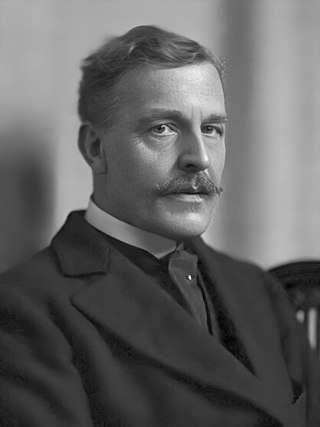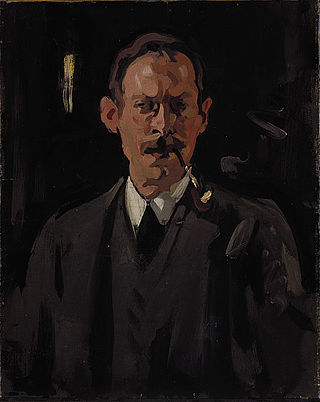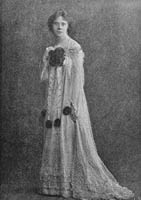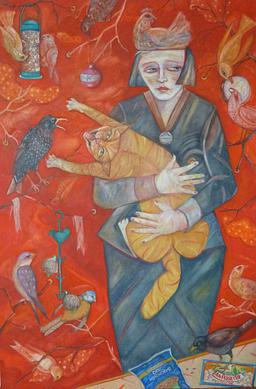Related Research Articles
The Scottish Colourists were a group of four painters, three from Edinburgh, whose Post-Impressionist work, though not universally recognised initially, came to have a formative influence on contemporary Scottish art and culture. The four artists, Francis Cadell, John Duncan Fergusson, Leslie Hunter and Samuel Peploe, were prolific painters spanning the turn of the twentieth century until the beginnings of World War II. While now banded as one group with a collective achievement and a common sense of British identity, it is a misnomer to believe their artwork or their painterly careers were heterogeneous.

Anna "Nan" Shepherd was a Scottish Modernist writer and poet, best known for her seminal mountain memoir, The Living Mountain, based on experiences of hill walking in the Cairngorms. This is noted as an influence by nature writers who include Robert Macfarlane and Richard Mabey. She also wrote poetry and three novels set in small fictional communities in Northern Scotland. The landscape and weather of this area played a major role in her novels and provided a focus for her poetry. Shepherd served as a lecturer in English at the Aberdeen College of Education for most of her working life.
The Glasgow School was a circle of influential artists and designers that began to coalesce in Glasgow, Scotland in the 1870s, and flourished from the 1890s to around 1910. Representative groups included The Four, the Glasgow Girls and the Glasgow Boys. Part of the international Art Nouveau movement, they were responsible for creating the distinctive Glasgow Style.

Sir James Guthrie was a Scottish painter, associated with the Glasgow Boys. He is best known in his own lifetime for his portraiture, although today more generally regarded as a painter of Scottish Realism.

Dame Elizabeth Violet Blackadder, Mrs Houston, was a Scottish painter and printmaker. She was the first woman to be elected to both the Royal Scottish Academy and the Royal Academy.

Gray's School of Art is the Robert Gordon University's art school, located in Aberdeen, Scotland. It is one of the oldest established fine art institutions in Scotland and one of Scotland's five art schools today, and ranked among the Top 20 Schools of Art and Design in the United Kingdom. The School is housed in a modernist building at the university's Garthdee campus in Aberdeen. As well as degree-level training in fine art, applied art and design, Gray's School of Art offers short courses and evening classes to the general public in a wide variety of mediums. Many of these are designed for those with no previous formal training, and can also be used to develop a portfolio prior to applying for degree-level study. The School also mounts exhibitions, including the annual Degree Show which showcases the work of students on its programmes.

Samuel John Peploe was a Scottish Post-Impressionist painter, noted for his still life works and for being one of the group of four painters that became known as the Scottish Colourists. The other colourists were John Duncan Fergusson, Francis Cadell and Leslie Hunter.

Frances MacDonald MacNair was a Scottish artist whose design work was a prominent feature of the Modern Style during the 1890s.
Dame Ethel Walker was a Scottish painter of portraits, flower-pieces, sea-pieces and decorative compositions. From 1936, Walker was a member of The London Group. Her work displays the influence of Impressionism, Puvis de Chavannes, Gauguin and Asian art. Walker achieved considerable success throughout her career, becoming the first female member elected to the New English Art Club in 1900. Walker's works were exhibited widely during her lifetime, at the Royal Academy, the Royal Society of Arts and at the Lefevre Gallery. She represented Britain at the Venice Biennale four times, in 1922, 1924, 1928 and 1930. Although Walker proclaimed that 'there is no such thing as a woman artist. There are only two kinds of artist — bad and good', she was elected Honorary President of the Women's International Art Club in 1932. Soon after her death, she was the subject of a major retrospective at the Tate in 1951 alongside Gwen John and Frances Hodgkins. Walker is now acknowledged as a lesbian artist, a fact which critics have noted is boldly apparent in her preference for women sitters and female nudes. It has been suggested that Walker was one of the earliest lesbian artists to explore her sexuality openly in her works. While Walker was contemporarily regarded as one of the foremost British women artists, her influence diminished after her death, perhaps due in part to her celebration of female sexuality. Made a Dame Commander of the Order of the British Empire in 1943, Walker was one of only four women to receive the honour as of 2010.

James William Giles ARSA was a Scottish landscape painter. Several of his landscapes were commissioned and purchased by Queen Victoria and members of the Scottish aristocracy. He was a member of the Royal Scottish Academy.

Joan Kathleen Harding Eardley was a British artist noted for her portraiture of street children in Glasgow and for her landscapes of the fishing village of Catterline and surroundings on the North-East coast of Scotland. One of Scotland's most enduringly popular artists, her career was cut short by breast cancer. Her artistic career had three distinct phases. The first was from 1940 when she enrolled at the Glasgow School of Art through to 1949 when she had a successful exhibition of paintings created while travelling in Italy. From 1950 to 1957, Eardley's work focused on the city of Glasgow and in particular the slum area of Townhead. In the late 1950s, while still living in Glasgow, she spent much time in Catterline before moving there permanently in 1961. During the last years of her life, seascapes and landscapes painted in and around Catterline dominated her output.

Joyce W. Cairns is a Scottish painter and printmaker based in Broughty Ferry, Scotland. In 2018, she was elected president of the Royal Scottish Academy (RSA).
Frances Richards was a British painter, embroiderer, and illustrator.
Frances Macdonald, was an English painter known for her panoramic scenes painted in Wales, the south of France and in London during World War II.
Barbara Davis Rae CBE RA FRSE is a Scottish painter and printmaker. She is a member of the Royal Scottish Academy and the Royal Academy of Arts.
Victoria Elizabeth Crowe OBE, DHC, FRSE, MA (RCA) RSA, RSW is a Scottish artist known for her portrait and landscape paintings. She has works in several collections including the National Galleries of Scotland, the National Portrait Gallery, London, and the Royal Scottish Academy.
Victorine Anne Foot was a British artist who worked in oils, watercolours and pastels. Foot is best known for her work during World War II on military camouflage and for her post-war career as an artist and teacher in Scotland.

Stansmore Richmond Leslie Dean Stevenson was a Scottish artist known for her oil paintings. She was a member of a group of women artists and designers known as the Glasgow Girls.
Barbara Balmer RSA was a Scottish artist and teacher.
Beth Fisher (b.1944) is an artist, printmaker and member of the Royal Scottish Academy and the Society of Scottish Artists. She was born in Portland, Maine and studied at the University of Wisconsin and at the Ruskin School of Drawing and Fine Art, Oxford. She moved to the United Kingdom from the United States in the 1960s to study in Oxford for a year, and married her husband Nick Fisher in 1967. After completing postgraduate studies in the United States, they both returned to the United Kingdom in 1970, moving to Glasgow in 1971 and Aberdeen in 1976. Fisher has worked at both Glasgow Print Studio and Peacock Visual Arts in Aberdeen, and helped to establish both workshops. She was a founder member of Glasgow Print Studio in 1972, and was responsible for co-running the workshop for the first few years, with Sheena McGregor. She was elected an Associate member of the Royal Scottish Academy in 1989, in the membership category for printmakers, shortly after the academy introduced the category.
References
- 1 2 Vidinova, Nadia (14 May 2016). "Antarctic paintings 'most significant donation by an artist' to Dundee in a generation". The Courier. Retrieved 1 June 2023.
- 1 2 3 Macmillan, Duncan (5 November 2018). "Art reviews: Frances Walker | Henry Kondracki | David Martin". The Scotsman. Retrieved 1 June 2023.
- ↑ "Frances Walker: Printing On". Aberdeen City Council. Aberdeen Archives, Gallery & Museums. 29 March 2022. Retrieved 7 October 2023.
- ↑ "Frances Walker". Peacock - a workshop for art. Retrieved 1 June 2023.
- 1 2 "Frances Walker". The Scottish Gallery. Retrieved 1 June 2023.
- ↑ "Walker, Frances, b.1930". Art UK. Retrieved 1 June 2023.
- ↑ "Frances Walker". National Galleries. Retrieved 1 June 2023.
- ↑ "Frances Walker: Printing On". Peacock - a workshop for art. Retrieved 1 June 2023.